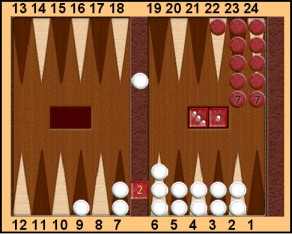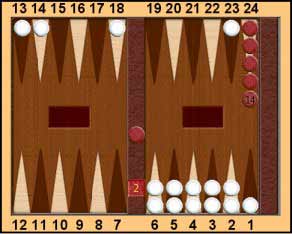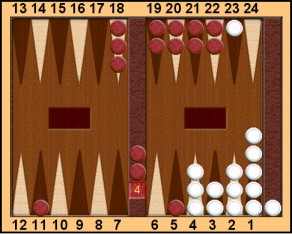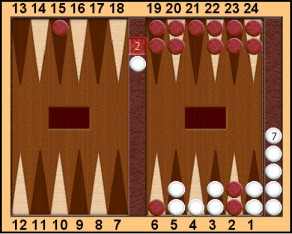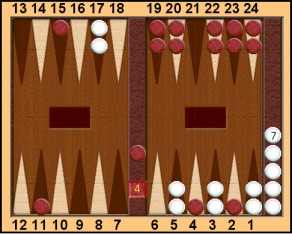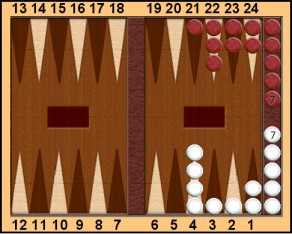
|
Cube Strategy |

|
Too Good? Too Bad! |
| Paul Lamford |
|
This article originally appeared at www.msoworld.com April 2000 |
For once, you hit the last-ditch shot from the bar, and you notice that your board is still intact, and think "Can't pick up another man, must be a cash." So you redouble to 4. Surprisingly, this is quite a large error, as there are still gammons, and, with careful cube-handling, virtually no losses. You have very little chance of picking up a second man, but it costs you nothing to torture the other guy for a while and try for the 8% gammons when you close out one man. One of my favourite positions:
I discovered this position when writing a survey of 5-1/2 point boards, one of many articles rightly considered much too tedious for the BIBAfax. (A copy can be obtained by sending a large SAE to me at 8 Arbor Court, London N16 0QU). The position has confused a number of strong players. It is, astonishingly, too good as White wins about 6% gammons, and Black gets a take next turn only if he rolls 6-1 and even then it is no sinecure. Anyway, I digress from the main theme of this article. Only in a tournament game can a position be both "too good and too bad" at the same time. You may have heard the expression "too good but not good enough", which refers to the same concept. For a position to be "too good and too bad," the following requirements must hold:
The cube-owned match equity must also be greater than the cube-given-away match equity. Snowie frequently mis-evaluates such positions at first, at 3-ply, as "too good to redouble, pass". When it does its cubeful rollouts, however, it discovers that the position is "no redouble, take". I was fortunate that both my "too good and too bad" positions featured in events with a significant first prize. Oddly, they both occurred at scores where you would not expect to find them. The first was against Dod Davies (Black) in the Fox Ladder Final Play-Off, 1998/9:
Despite trailing in the match, and going 11-5 down if I lost, it is wrong for me to redouble here, and it is an easy take for Dod. The massive one-way gammon threat, perfectly efficient for the player 8 away, combined with the significant losing chances, make the position "too good and too bad" at the same time. For money it is a double and take, as Black gets gammoned a lot when White pops a six but he wins about 40% of games to compensate. However, the reason White should not double at the match score is because he kills his own gammon threat, and does better with the cube owned, retaining his equity at 8-away, 2-away when he does not escape. In a rare moment of perceptiveness, I correctly rolled on, and I can still remember Dod slumping back in his chair when my double six popped out of the cup. (No marks for working out how to play them.) His valiant efforts to save the gammon proved unsuccessful. Both Dod and the chair have since recovered. The same scenario cropped up again at a recent event; this was the 16-player, invitation jackpot organised by James Vogl at the Globe Tennis Club in Haverstock Hill, North London. It happened at an even more unlikely score, 0 to 0 in a 15-point match. We start with an interesting cube decision:
David Levy (Black) redoubled to 4 here and I thought for a while before taking. Interestingly, Snowie assesses the position as no redouble/take, which surprised me. The take is easy, once you consider the different variations. His very best is 6-2 (or 2-2) and even then he is not gin by any means. If he just covers, White has seven men off and Black may never hit the other man. The reason it may be no redouble is that the market loss on covering is not great enough. Cubeful rollouts were too close to call, and doubling is only a tiny error if it is one. Passing would be a major blunder. David rolled 5-2, hitting with 23/21* and playing 19/14 and I replied with the huge joker 4-4, played bar/20*(2), 20/16(2), and David danced leading to the following position:
Snowie, at level 3, mis-assesses this position as "too good to redouble/pass", but gets it right with cubeful rollouts as "no redouble/take". The point is that after David takes an 8-cube, he will be able to redouble to 16 with any shot, killing my gammons and forcing me to take for the match. The huge one-way gammon threat and the high win rate for Black combine to create a "too good, too bad" situation. This an unusual result at 0 to 0 in a long match, but the 4 cube is the main culprit. I decided after a while to roll on and David commented immediately, "for the record, I was taking." I rolled a 3-2, correctly (according to Snowie) played 17/15*, 15/12, and I joked to David, "you can't roll double fours as well, surely." "I never do," he replied, but he broke his promise and rolled 4-4, hitting on my 12-point. I entered with 4-3 (another poser; I played bar/18, to which Snowie rollouts just gave the edge, but it is very close) and David missed, but he later hit a shot and won a very exciting game. Fortunately, I rolled well later to win the match, but it could so easily have been 15-0 if I had redoubled to 8! So a game of the double fours, which reminds me of a little exchange of whimsy on FIBS, where I played regularly as "gap". I reached the following position:
My opponent, andyp, known to fibsters with an additional "andy" for obvious reasons, is Andy Plater, a strong player who leapt in at number one on the BIBA/Crane "double jeopardy" rating system for new players. I rolled 3-2 here, bearing two off, and Andy quipped "mind the gap". He rolled something which took two off, and I retorted "stand clear of the double fours", before rolling them to end the game! Answer to: Why don't owls have sex in the rain?
Article © 2000 by Paul Lamford. |

![]()
|
| Other articles on Going For Gammon |
Return to:
Backgammon Galore
 Why don't owls have sex in the rain?
Why don't owls have sex in the rain?